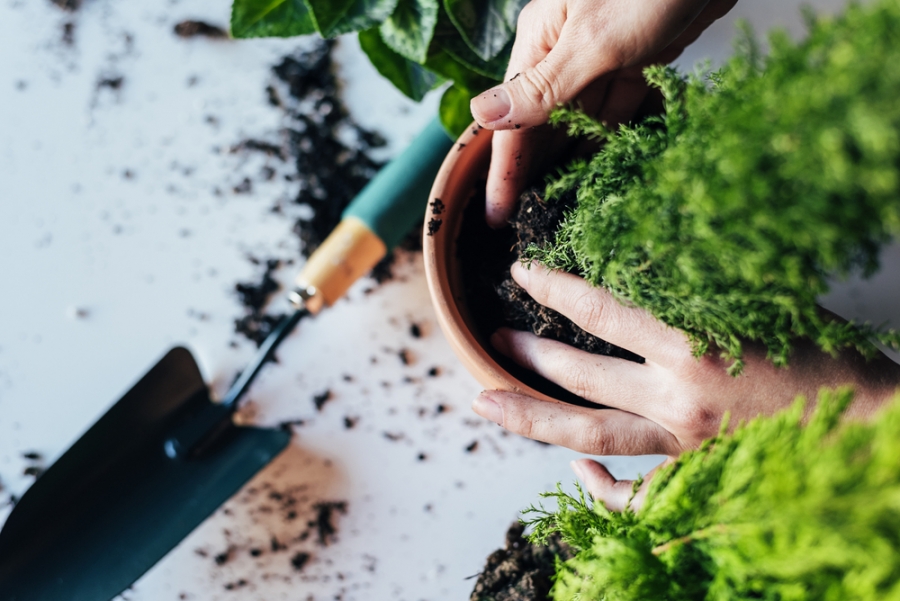Indoor houseplants can be a breath of fresh air – literally. Not only does that spider plant you’ve lovingly cultivated brighten up your living room, it’s also constantly working to maintain your indoor air quality, keeping it fresh and healthy.
This is good news, considering that indoor air quality can be up to 5 times more polluted than the air outdoors. Pollutants can come from outdoors or indoors, and dust mites, pollen, and chemicals can build up to dangerous levels, causing things like sick building syndrome and worsening conditions like asthma.
Considering that people typically spend 80% to 90% of their time indoors, this is a big deal. Environmentalist scientists say that indoor air pollution is going to be a realistic threat to human health in the future, so now’s the time to act. But how exactly can houseplants improve indoor air quality, and which ones should you choose for the best results?
Increasing Oxygen
First and foremost, as you probably remember from science class, plants remove carbon dioxide from the air and release oxygen via photosynthesis. Studies have shown that buildings with a large number of plants result in a higher blood oxygen level among the people spending time there.
Of course, for maximum impact, you have to treat your plants right. Healthy plants that get plenty of direct sunlight perform best. If plants don’t receive enough light, they can actually start to take in oxygen and release carbon dioxide — the exact opposite of what you want.
Removing Pollutants
Along with removing carbon dioxide from the air, houseplants can also remove a significant quantity of toxic chemicals. NASA discovered this back in 1989, when they were studying how to improve the indoor air quality of space ships.
The study found that indoor plants remove substantial amounts of chemicals like benzene, formaldehyde, and trichloroethylene from the air. These chemicals are found in everything from nylon to pesticides, paper bags to plywood paneling, and printer ink to varnishes. It’s virtually impossible to completely avoid these chemicals, but plants can reduce their levels.
NASA found that plants manage the toxic particulates in two ways: they metabolize or process them into harmless byproducts like they do carbon dioxide, or they can absorb heavy metals into their own tissues and store them safely there.
The impact is notable. In one case, they were able to use plants to reduce formaldehyde levels in a travel trailer from potentially toxic levels of 0.18 parts per million (ppm) to 0.03 ppm, which is deemed safe by the World Health Organization.
Dirt Cleans
It’s not just plants doing all the work, either – the very dirt they grow in has an important function, too. NASA’s first tests were carried out on hydroponically grown plants, but later tests using plants grown in soil showed even more promising results.
Certain microbes that live in the soil of indoor plants are capable of biodegrading toxic chemicals like benzene and formaldehyde. The microbes vary between plants and between environments, but the study suggested that soil plays a large role in the elimination of certain toxins from the air indoors.
Interestingly, the soil seemed to have more of an impact when it was activated by root growth. This means the soil and the plant have the greatest impact when working together.
Top-Performing Plants
Not all houseplants are created equal when it comes to improving indoor air quality. Fortunately, the tests by NASA and others since then have helped identify some of the best performers that you can buy today.
Spider Plant
If you don’t have a spider plant already, you probably know someone who does. This popular houseplant is easy to grow and tough to kill, which is an ideal combination for those lacking a green thumb. Spider plants thrive in bright, indirect sunlight. They remove formaldehyde and xylene, and the shoots (or “spiderettes”) they put out mean you’ll have plenty of baby spider plants to share with friends.
Peace Lily
If you like fragrant flowers, a peace lily might be for you. They have beautiful-smelling flowers throughout the summer, although this does add pollen in the air — so if you have allergies, exercise caution. They may be small, but they thrive in shady areas and effectively remove ammonia, benzene, formaldehyde, and trichloroethylene.
Snake Plants
A strikingly tall and hardy option, snake plants can live in low light and need very little attention. They can remove benzene, xylene, formaldehyde, and trichloroethylene. But be warned: these plants are toxic to dogs and cats.
Boston Fern
A lush option that can thrive both indoors and outdoors is the Boston Fern. They require a little more attention, so make sure their soil is consistently moist. These ferns can remove toluene along with xylene and formaldehyde from the air.
Aloe Vera
If you want a versatile, multi-use plant, aloe vera should do the trick. It can help skin conditions with its blend of vitamins and amino acids, and is a popular topical sunburn remedy. Some people even eat it! In terms of its filtration abilities, it’s a great option for removing formaldehyde.
There’s Something in the Air
Plants don’t just improve the air indoors. They also improve the overall environment. Hospital patients who have plants in their rooms are more positive and have lower stress levels and blood pressure, while people who have plants in their offices concentrate more easily and perform better at certain tasks.
And of course, while it’s harder to measure, you can’t discount the simple pleasure many people get from tending to their plants and enjoying the charm they add to a room.
Pairing Plants and Air Quality Filtration
NASA’s first tests were conducted in environments that used plants and air quality filtration systems together, so it’s important to recognize how important those systems are to improving indoor air quality.
But while filtration systems remove many pollutants and improve the symptoms of issues like asthma, they still don’t reduce the levels of all indoor pollutants. By supplementing your air quality filtration system with some high-performing plants, you’ll get cleaner and healthier air, as well as some bonus beautification.






